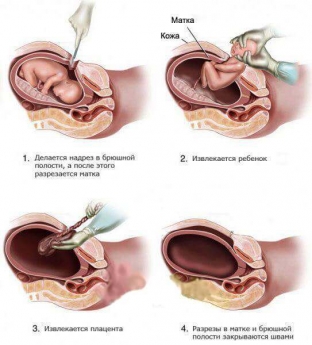Caesarean section – This is a surgical intervention that is performed in obstetric practice in order to extract the fetus through an incision in the anterior abdominal wall and uterus. This operation is one of the most ancient, as there is information about the use of caesarean section in Rome several centuries BC. Initially, the operation was performed only in case of death of the mother, in order to extract a live fetus. To date, the operation of caesarean section has undergone many modifications, indications for its implementation have significantly expanded and conditions have improved.
What kind of caesarean section techniques are used today
Cesarean section is the best option if vaginal delivery is not possible or may lead to complications. To date, caesarean sections are performed mainly under epidural anesthesia, so that the mother can hear the first cry of the child and observe his first seconds of life, as in natural childbirth. There are several main methods for performing a caesarean section: intraperitoneal or extraperitoneal caesarean section, as well as the Stark method. estet-portal.com tells more about these techniques.
Caesarean section operation:
- intraperitoneal caesarean section technique;
- Caesarean section by Stark method;
- extraperitoneal caesarean section technique.
Intraperitoneal caesarean section
Technique for performing a caesarean section in the lower segment of the uterus with a transverse incision:
- the anterior abdominal wall is dissected by a lower median laparotomy or by a Pfannenstiel incision;
- the vesicouterine fold is dissected a few centimeters above the point of its attachment to the bladder in the transverse direction to the round ligaments;
- a transverse incision of the uterus is made one centimeter below the incision site of the fold;
- The technique of fetal extraction depends on the position of the fetus in the uterus and its presentation;
- the uterus is massaged through the anterior abdominal wall with simultaneous pulling of the umbilical cord to extract the placenta;
- after prevention of septic complications, the incision is sutured.
Stark caesarean section
 Modification of Starck's caesarean section involves making an incision in the lower segment of the uterus without prior separation of the bladder, extending the incision to the extreme points of the head. Then the fetal bladder is opened, the fetus and placenta are removed, the uterus is removed from the abdominal cavity and massaged to reduce it. Then the uterus is sutured, the peritoneum and muscles of the anterior abdominal wall are not sutured, and the aponeurosis is also sutured. The advantages of this operation are the shortening of its duration, much less blood loss, easy extraction of the fetus and less pain in the postoperative period.
Modification of Starck's caesarean section involves making an incision in the lower segment of the uterus without prior separation of the bladder, extending the incision to the extreme points of the head. Then the fetal bladder is opened, the fetus and placenta are removed, the uterus is removed from the abdominal cavity and massaged to reduce it. Then the uterus is sutured, the peritoneum and muscles of the anterior abdominal wall are not sutured, and the aponeurosis is also sutured. The advantages of this operation are the shortening of its duration, much less blood loss, easy extraction of the fetus and less pain in the postoperative period.
Extraperitoneal caesarean section technique
Extraperitoneal caesarean section according to the Morozov method is performed in case of suspicion or presence of an infectious process, in the absence of conditions for natural childbirth. To perform this method of caesarean section, the surgeon must be highly skilled. The operation procedure is as follows:
- the abdominal wall is dissected with a suprapubic incision;
- the rectus abdominis muscles are divided in a blunt way, the pyramidal – sharp;
- the right rectus muscle is peeled off and retracted to the right;
- disconnect exposed connective tissue to the pelvic fascia;
- the pelvic fascia is opened and fingers are passed to the left rib of the uterus;
- the vesicouterine fold and the top of the bladder are retracted to the right, opening the lower segment of the uterus;
- the uterus is opened and the fetus is removed;
- the uterine wound is sutured and the abdominal wall is sutured in layers.







Add a comment